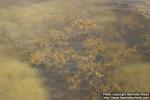[
 Preparation: Fluid Extract of Fucus
Preparation: Fluid Extract of Fucus
Related entries: Laminaria
The marine plant, Fucus vesiculosus, Linné.
Nat. Ord.—Fucoideae.
COMMON NAMES: Bladder-wrack, Sea-wrack, Cut-weed, Kelp-ware, Black-tang, Quercus marina.
ILLUSTRATION: Bentley and Trimen, Med. Plants, 304.
Botanical Source.—Fucus vesiculosus is a perennial sea-weed. Its root is a hard, flattish disk. The frond or thallus ranges from a few inches to 4 feet in length, and from 2 lines to an inch in width, is flat, furnished with a midrib throughout its length, occasionally twisted in a spiral manner, repeatedly dichotomous, the angles of the dichotomy acute, except when a solitary vesicle happens to be placed there; the sterile branches are obtuse, and often notched at the extremity. The air-vessels vary from the size of a pea to a hazel-nut, and are placed in pairs, situated at irregular intervals in different parts of the frond; sometimes 2 or 3 pairs are arranged next to each other; and they are rarely altogether wanting. The receptacles are terminal, compressed, mostly ovate or elliptical, about ½ inch long, but varying from nearly spherical to linear-lanceolate, and from ¼ inch to nearly 2 inches long; they are mostly in pairs, but are sometimes solitary, and occasionally forked. They are filled with a clear, tasteless mucus. The whole frond is proliferous in a remarkable degree in cases of injury, throwing out numerous new shoots from the injured part
History, Description, and Chemical Composition.—Fucus vesiculosus, Sea-wrack, or Bladder fucus, is a common marine plant, growing upon the sea shores of Europe and America. Its substance is rather thick, but flexible and tough, with a dark, olivaceous, glossy-green color, paler at the extremities, and becoming black by drying. Its odor is strong, its taste quite disagreeable, and it contains cellulose, mucilage, mannit, odorous oil, coloring and bitter matters, sodium, and potassium combined with iodine, bromine, and chlorine. The ash of this plant amounts to about 3 per cent; of this ash, iodine constitutes about 0.7 per cent. On account of the iodine contained in its charcoal, known as Vegetable ethiops (Aethiops vegetabilis), it has been found beneficial in scrofulous enlargements of the glands; the plant being incinerated in a covered crucible, and the charcoal given in doses of from 10 grains to 2 drachms. When burned in the open air it yields kelp; it is used as a manure in some places, and is also fed to cattle during the winter. Probably other species of Fucus have analogous virtues.
Action, Medical Uses, and Dosage.—M. Duchesne Duparc recommended an infusion of this plant or the extract in pill form for the purpose of lessening obesity. It requires to be used 3 or 4 weeks before this effect will be observed, which is preceded with an augmented secretion of urine, presenting a black pellicle upon its surface upon standing for a short time. Others have confirmed this statement regarding it. Later experiments by numerous good observers do not seem to indicate that sea-wrack has any power as a fat-reducer, but that the reduction which takes place in some instances is undoubtedly due to the dietary measures which are a part of the treatment. It is thought, however, to have some power of toning muscular fiber, and has been suggested to prevent fatty degeneration of the heart. It influences the kidneys, lessening renal congestion and resultant irritation, and is therefore of service in acute desquamative nephritis; it also relieves cystic irritation and chronic inflammation of the bladder. Take of specific fucus from 5 to 20 drops, every 3 hours. It was at one time recommended to remove deposits and tissue hypertrophies, as well as benign and malignant tumors. It is a remedy which deserves a careful investigation, especially in regard to its influence over waste and nutrition. It acts quite powerfully upon the glandular system as an alterative, and is recommended for menstrual derangements with weak, flabby uterine walls. Dose, of specific fucus, 5 to 30 drops.
Related Species.—The following plants are thought to possess similar properties, the first mentioned having been allowed by the French Codex as a substitute for bladder-wrack: Fucus siliquosus, Linné, (Cystoseira siliquosa, Agardh; Halidrys siliquosa, Lyngbye), Fucus serratus, Linné, Fucus natans, Linné (Sargassum bacciferrum, Agardh), Fucus nodosus, Linné, (Fucodium nodosum, Agardh). Fucus digitatus contains much more iodine (7 or 8 times as much) than bladder-wrack

